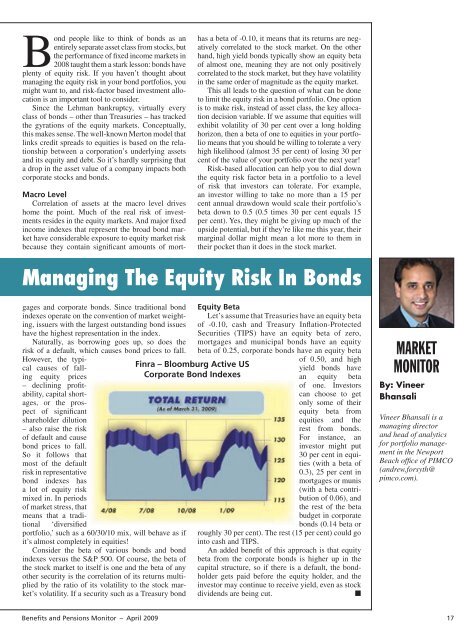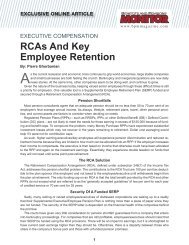April - Benefits and Pensions Monitor
April - Benefits and Pensions Monitor
April - Benefits and Pensions Monitor
Create successful ePaper yourself
Turn your PDF publications into a flip-book with our unique Google optimized e-Paper software.
Bond people like to think of bonds as an<br />
entirely separate asset class from stocks, but<br />
the performance of fixed income markets in<br />
2008 taught them a stark lesson: bonds have<br />
plenty of equity risk. If you haven’t thought about<br />
managing the equity risk in your bond portfolios, you<br />
might want to, <strong>and</strong> risk-factor based investment allocation<br />
is an important tool to consider.<br />
Since the Lehman bankruptcy, virtually every<br />
class of bonds – other than Treasuries – has tracked<br />
the gyrations of the equity markets. Conceptually,<br />
this makes sense. The well-known Merton model that<br />
links credit spreads to equities is based on the relationship<br />
between a corporation’s underlying assets<br />
<strong>and</strong> its equity <strong>and</strong> debt. So it’s hardly surprising that<br />
a drop in the asset value of a company impacts both<br />
corporate stocks <strong>and</strong> bonds.<br />
Macro Level<br />
Correlation of assets at the macro level drives<br />
home the point. Much of the real risk of investments<br />
resides in the equity markets. And major fixed<br />
income indexes that represent the broad bond market<br />
have considerable exposure to equity market risk<br />
because they contain significant amounts of morthas<br />
a beta of -0.10, it means that its returns are negatively<br />
correlated to the stock market. On the other<br />
h<strong>and</strong>, high yield bonds typically show an equity beta<br />
of almost one, meaning they are not only positively<br />
correlated to the stock market, but they have volatility<br />
in the same order of magnitude as the equity market.<br />
This all leads to the question of what can be done<br />
to limit the equity risk in a bond portfolio. One option<br />
is to make risk, instead of asset class, the key allocation<br />
decision variable. If we assume that equities will<br />
exhibit volatility of 30 per cent over a long holding<br />
horizon, then a beta of one to equities in your portfolio<br />
means that you should be willing to tolerate a very<br />
high likelihood (almost 35 per cent) of losing 30 per<br />
cent of the value of your portfolio over the next year!<br />
Risk-based allocation can help you to dial down<br />
the equity risk factor beta in a portfolio to a level<br />
of risk that investors can tolerate. For example,<br />
an investor willing to take no more than a 15 per<br />
cent annual drawdown would scale their portfolio’s<br />
beta down to 0.5 (0.5 times 30 per cent equals 15<br />
per cent). Yes, they might be giving up much of the<br />
upside potential, but if they’re like me this year, their<br />
marginal dollar might mean a lot more to them in<br />
their pocket than it does in the stock market.<br />
Managing The Equity Risk In Bonds<br />
gages <strong>and</strong> corporate bonds. Since traditional bond<br />
indexes operate on the convention of market weighting,<br />
issuers with the largest outst<strong>and</strong>ing bond issues<br />
have the highest representation in the index.<br />
Naturally, as borrowing goes up, so does the<br />
risk of a default, which causes bond prices to fall.<br />
However, the typical<br />
causes of falling<br />
equity prices<br />
– declining profitability,<br />
capital shortages,<br />
or the prospect<br />
of significant<br />
shareholder dilution<br />
– also raise the risk<br />
of default <strong>and</strong> cause<br />
bond prices to fall.<br />
So it follows that<br />
most of the default<br />
risk in representative<br />
bond indexes has<br />
a lot of equity risk<br />
mixed in. In periods<br />
of market stress, that<br />
means that a traditional<br />
‘diversified<br />
portfolio,’ such as a 60/30/10 mix, will behave as if<br />
it’s almost completely in equities!<br />
Consider the beta of various bonds <strong>and</strong> bond<br />
indexes versus the S&P 500. Of course, the beta of<br />
the stock market to itself is one <strong>and</strong> the beta of any<br />
other security is the correlation of its returns multiplied<br />
by the ratio of its volatility to the stock market’s<br />
volatility. If a security such as a Treasury bond<br />
Finra – Bloomburg Active US<br />
Corporate Bond Indexes<br />
Equity Beta<br />
Let’s assume that Treasuries have an equity beta<br />
of -0.10, cash <strong>and</strong> Treasury Inflation-Protected<br />
Securities (TIPS) have an equity beta of zero,<br />
mortgages <strong>and</strong> municipal bonds have an equity<br />
beta of 0.25, corporate bonds have an equity beta<br />
of 0.50, <strong>and</strong> high<br />
yield bonds have<br />
an equity beta<br />
of one. Investors<br />
can choose to get<br />
only some of their<br />
equity beta from<br />
equities <strong>and</strong> the<br />
rest from bonds.<br />
For instance, an<br />
investor might put<br />
30 per cent in equities<br />
(with a beta of<br />
0.3), 25 per cent in<br />
mortgages or munis<br />
(with a beta contribution<br />
of 0.06), <strong>and</strong><br />
the rest of the beta<br />
budget in corporate<br />
bonds (0.14 beta or<br />
roughly 30 per cent). The rest (15 per cent) could go<br />
into cash <strong>and</strong> TIPS.<br />
An added benefit of this approach is that equity<br />
beta from the corporate bonds is higher up in the<br />
capital structure, so if there is a default, the bondholder<br />
gets paid before the equity holder, <strong>and</strong> the<br />
investor may continue to receive yield, even as stock<br />
dividends are being cut.<br />
n<br />
Market<br />
<strong>Monitor</strong><br />
By: Vineer<br />
Bhansali<br />
Vineer Bhansali is a<br />
managing director<br />
<strong>and</strong> head of analytics<br />
for portfolio management<br />
in the Newport<br />
Beach office of PIMCO<br />
(<strong>and</strong>rew.forsyth@<br />
pimco.com).<br />
<strong>Benefits</strong> <strong>and</strong> <strong>Pensions</strong> <strong>Monitor</strong> – <strong>April</strong> 2009<br />
17









